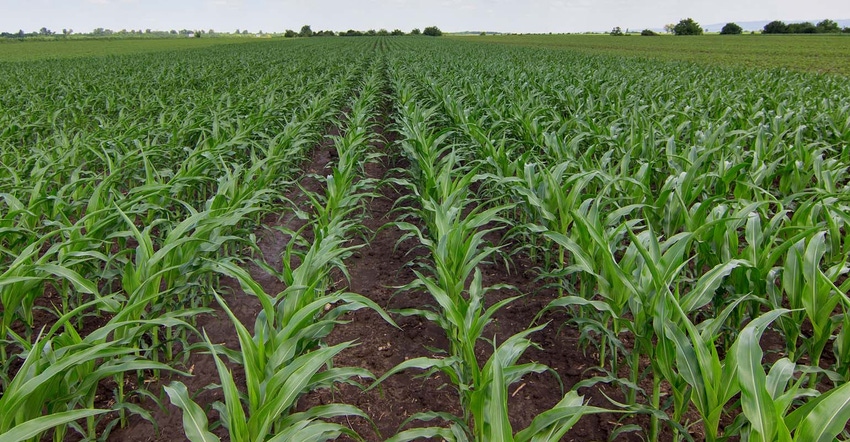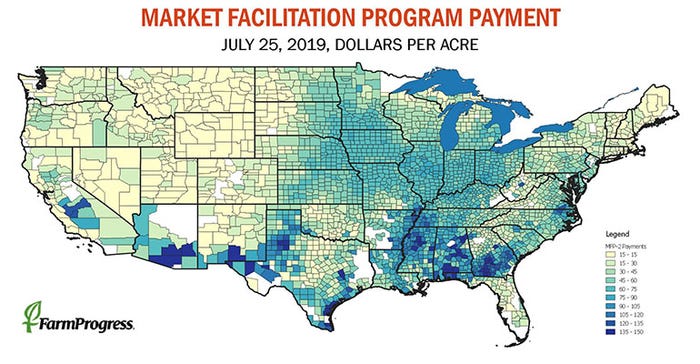
Updated: Livestock producers, speciality crop growers will receive payments too
Producer payments range from $15 per acre to $150 per acre in the 2019 edition of the Market Facilitation Program.
The program was structured to avoid influencing farmers’ planting decisions, USDA officials emphasized during a Tuesday morning conference call. It also took into account the historically wet spring and delayed planting as it crafted the second version of the program.
“Our team at USDA reflected on what worked well and gathered feedback on last year’s program to make this one even stronger and more effective for farmers,” said Agriculture Secretary Sonny Perdue.
Perdue was joined by USDA’s Chief Economist, Dr. Rob Johannson, Under Secretary for Farm Production and Conservation Bill Northey and Acting Deputy Under Secretary for Food, Nutrition, and Consumer Services Brandon Lipps to release the details of the report.
Producers may begin signing up for the program on July 29, 2019, with signup ending Dec. 6, 2019. The first round of payments will be issued in mid to late August and payments will be made in three parts, depending on the county payment rate.
If your county payment rate is $15 per acre, you will receive your entire payment in the first round, Northey said. For those whose payment is higher, such as the $69 per acre in Polk County, Iowa, the first payment will be 50% of that amount. The second and third payment, anticipated to be paid in November and January, will contain the remainder of the payment and be subject to trade conditions at that time.
Producers who filed prevented planting claims and then planted an MFP-eligible cover crop are eligible for a $!5 per acre payment. Cover crops must be planted by Aug. 1, 2019, to be considered eligible for MFP payments.
The MFP payments will go to non-specialty and specialty crop producers as well as hog and dairy producers.
Eligible crops
Non-specialty crops, including: alfalfa hay, barley, canola, corn, crambe, dried beans, dry peas, extra-long staple cotton, flaxseed, lentils, long grain and medium grain rice, millet, mustard seed, oats, peanuts, rapeseed, rye, safflower, sesame seed, small and large chickpeas, sorghum, soybeans, sunflower seed, temperate japonica rice, triticale, upland cotton, and wheat.
Specialty crops, including almonds, cranberries, cultivated ginseng, fresh grapes, fresh sweet cherries, hazelnuts, macadamia nuts, pecans, pistachios, and walnuts.
Payment rates for specialty crops include: Nuts: $146 per acre; Cranberries: $.03 per pound at 21,371 pounds per acre; Ginseng: $2.85 per pound at 2,000 pounds per acre; Sweet cherries (fresh): $0.17 per pound at 9,148 pounds per acre, and Table grapes: $0.03 per pound at 20,820 pounds per acre.
The 2019 trade assistance package for farmers is valued at $16 billion, with $14.5 billion dedicated to Market Facilitation Program payments, $1.4 billion for commodity purchases and $100 million for Agricultural Trade Promotion.
MFP payments are limited to a combined $250,000 for per person or legal entity. However, no applicant can receive more than $500,000. Eligible applicants must also have an average adjusted gross income for tax years 2014, 2015, and 2016 of less than $900,000 or, 75% of the person’s or legal entity’s average AGI for tax years 2014, 2015, and 2016 must have been derived from farming and ranching.
Check out how much your county payment is using the interactive map below. Zoom in with your computer mouse or cell phone/tablet to find the county you want, then click the flack on this interactive map to find the payment for a location.
Related: USDA's county list of Market Facilitation Program 2 payments
Livestock payments
Eligible U.S. pork producers will receive $11 per head based on inventory between April 1 and May 15, 2019. USDA will also make pork purchases of $208 million.
U.S. pork producers ship more than 25% of production to foreign markets and are highly dependent on trade, said National Pork Producers Council David Herring, a producer from Lillington, N.C. He and Jim Mulhern, President and CEO of the National Milk Producers Federation, both expressed appreciation for the aid, but stressed producers need “trade not aid.”
“Our top priorities are an end to the trade dispute with China, where retaliatory tariffs are preventing U.S. pork from fully capitalizing on a historic sales opportunity created by the outbreak of African swine fever in the world's largest pork-consuming nation, and a trade agreement with Japan, where U.S. pork is losing market share due to trade agreements Japan has recently formed with the EU and other international competitors," Herring said.
“Dairy producers have so far lost more than $2.3 billion in revenues since tariff escalation began in earnest one year ago,” said NMPF President and CEO Mulhern. “USDA’s new approach raises the level of aid to dairy farmers from last year’s program, a step in the right direction. We also urge the department to revise the outdated production history information used to calculate payments, which lessens the effectiveness of the program.”
Dairy producers who were in business as of June 1, 2019, will receive 20 cents per hundredweight on production history.
Destabilized market
California Walnut Growers Chairman William Carriere said tariff actions over the past year, including a base rate tariff change in India and retaliatory tariffs imposed in several of key markets including China, Turkey and India, destabilized the global walnut market driving pricing down significantly.
“These actions have threatened the stability of our industry, our growers and our competitiveness in the global market,” he said. “The economic impact to the industry has been devastating, with losses in excess of $600 MM (million). While these funds do not replace the losses, they will certainly help our growers through this difficult time.”
Lawmakers chime in
Lawmakers expressed support for farmers, but their view of the president's actions varied depending on their party affiliation.
House Agriculture Committee Ranking Member K. Michael Conaway, R-Texas, said, “The president has held firm in his commitment to defend America’s farmers and ranchers from China and other global trade cheats – understanding the toll these retaliatory tariffs have taken on family farmers and ranchers in an already depressed farm economy and offering a bridge to another year.”
Others weren’t so supportive of the administration’s actions, with the Democratic chairs of four House Agriculture Subcommittees issuing a joint statement. Livestock and Foreign Agriculture Chairman Jim Costa of California; Nutrition, Oversight, and Department Operations Chair Marcia L. Fudge of Ohio; General Farm Commodities and Risk Management Chair Filemon Vela of Texas; and Biotechnology, Horticulture, and Research Chair Stacey Plaskett of the Virgin Islands, raised concerns about the long-term impacts of the trade war, and fairness and equity of the payments.
“We are alarmed that this bailout will take valuable resources away from USDA’s implementation of programs in the 2018 Farm Bill and the recently passed Disaster Supplemental that help farmers in dire need,” the four lawmakers said. “And we’re very troubled that this second bailout comes alongside drastic cuts to nutrition programs for our most vulnerable. The administration needs to face the fact that its trade war isn’t accomplishing anything but added pain for our farmers.”
Sen. Debbie Stabenow, ranking member of the U.S. Senate Committee on Agriculture, Nutrition and Forestry, added, “The administration continues to move ahead with no real trade strategy. These short-term, inequitable payouts are not a replacement for markets and a coherent trade strategy. Today’s announcement only confirms my previous concerns that this aid is not equitable and favors certain farmers over others. Bottom line – it’s not fair.”
Reserving judgement
The National Corn Growers Association said it looked forward to learning more about the program.
“It’s no secret that farmers are facing difficult decisions amid wet spring weather, trade disputes and tariffs, and demand destruction in the ethanol market,” said NCGA President Lynn Chrisp. “While NCGA’s focus remains markets, we welcome USDA’s quick rollout of MFP 2.0 and the department’s creative efforts to reorient MFP to better reflect market impacts and support American farmers.”
The American Farm Bureau Federation expressed appreciation for the funding and hope that trade negotiations with China, Japan and the European Union would lead to agreement.
“These are difficult times for agriculture, and the longer these trade wars continue, the deeper the impact on farm country,” said American Farm Bureau Federation President Zippy Duvall. “Farmers are being hit with tariffs on top of already-challenging economic conditions from severe weather events, low commodity prices, lack of available labor and a host of other impacts. It’s the perfect storm for agriculture, and these continuing trade wars are adding to the increasing financial burden on our farmers and ranchers.”
Lavon, Texas, farmer and National Association of Wheat Growers President Ben Scholz said, “The MFP payments will provide necessary assistance to growers impacted by low prices resulting in part from tariffs. However, this is a band-aid when we really need a long-term fix. NAWG understands holding China accountable for its WTO violations and unfair trade practices but a trade war is not the solution especially when farmers are the casualties."
About the Author(s)
You May Also Like




